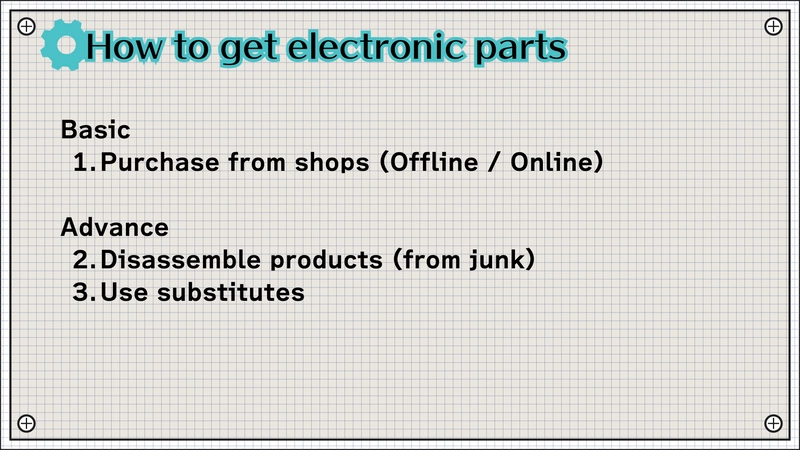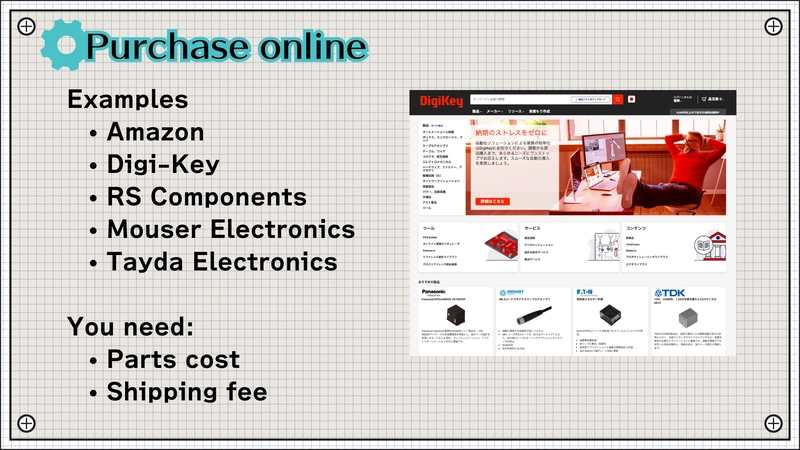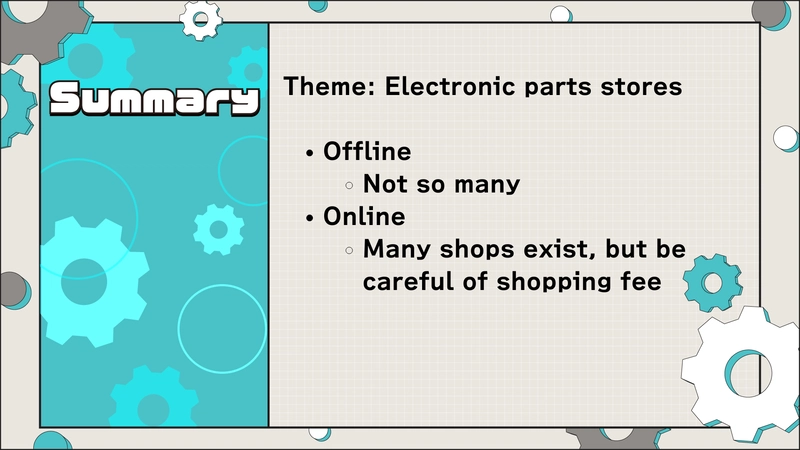How Beginners Can Get Electronic Parts
Hey devs, Buono here. So you're diving into hardware projects? Awesome! But one of the first hurdles is figuring out where to actually get all those resistors, capacitors, microcontrollers, and sensors. It can seem overwhelming at first. Let's break down the common ways beginners acquire electronic parts, focusing mainly on buying from shops. (Just a note: there are more advanced methods too, like carefully disassembling old electronics to salvage useful components, or finding substitute parts when your first choice isn't available due to the vast number of similar options. These can be great for saving money or finding rare items, but I plan to cover those techniques in more detail in the future). For now, let's stick to the most direct route for beginners: buying from shops. You generally have two choices: 1. Offline Shops (Physical Stores) This means going to a physical, brick-and-mortar store. Pros: You can see and handle the parts before buying, get them instantly without waiting for shipping, and sometimes chat with knowledgeable staff or other enthusiasts. The experience of visiting famous electronic districts can be inspiring! Cons: The biggest drawback is availability. Truly well-stocked electronics component shops are rare globally. You have to be geographically fortunate to live near one. Examples: Japan: Akihabara in Tokyo is legendary. I've spent a lot of time exploring shops there like Akizuki Denshi (秋月電子通商) – it's a fantastic resource. China: Huaqiangbei (华强北) in Shenzhen is on another level – absolutely massive, like a city dedicated to electronics. I've visited, and it's an overwhelming but incredible experience. Highly recommended if you ever get the chance. USA: Large stores dedicated purely to components are less common than they once were (the famous Fry's Electronics closed). However, stores like Micro Center do carry a decent range of components, microcontrollers, and maker supplies in many locations. Smaller local shops might also exist. Europe: Various shops exist across different countries, but you'll need to search specifically for component suppliers in your local area. If you do have access to a good local electronics shop, consider yourself lucky and definitely check it out! 2. Online Shops (The Go-To Option) For most people, buying online is the primary and most practical method today. Pros: Access to a massive selection of components from distributors worldwide, available 24/7 from your computer. You can usually find datasheets easily. Cons: You have to pay for shipping (which can be costly), wait for delivery, and can't physically inspect parts beforehand. Stock levels can sometimes be an issue for popular parts. Examples (Specialist Distributors): These companies focus entirely on electronic components and offer extensive catalogs, catering to professionals and hobbyists alike. Digi-Key (Known for a huge inventory) Mouser Electronics Arrow Electronics RS Components / Element14 (Farnell/Newark) (Major global operations) Example (General Retailers): Amazon, Aliexpress, etc.: These sites often carry common components, kits, and modules, especially those popular in the hobbyist community. It can be convenient, but finding detailed specs might be harder, and quality can vary from third-party sellers. Key Warning: Shipping Costs! This is crucial. Before clicking "buy" online: Check the shipping fees carefully. They vary significantly between vendors and shipping speeds. See if there's a minimum order value for free or reduced shipping. It might be worth adding a few extra parts you'll need later. Compare the total cost (parts + shipping + potentially tax) across different suppliers if you're buying multiple items. Sometimes a slightly higher part cost from one vendor is offset by cheaper shipping. Summary Beginners usually get parts by buying them. Offline shops offer an immediate, tangible experience but are geographically limited. Online shops provide vast selection and global access, making them the main option for most, but always be mindful of shipping costs and delivery times. Don't forget those advanced methods (salvaging, substitution) exist too – more on those later! Choosing the right source depends on your location, budget, and how quickly you need the parts. Happy component hunting! My channel explains essential tools and basics for electronics beginners learning from scratch. Subscribe for more videos and tips! Comments and likes on the video are always welcome. Wishing you a wonderful experience with your projects!

Hey devs, Buono here. So you're diving into hardware projects? Awesome! But one of the first hurdles is figuring out where to actually get all those resistors, capacitors, microcontrollers, and sensors. It can seem overwhelming at first. Let's break down the common ways beginners acquire electronic parts, focusing mainly on buying from shops.
(Just a note: there are more advanced methods too, like carefully disassembling old electronics to salvage useful components, or finding substitute parts when your first choice isn't available due to the vast number of similar options. These can be great for saving money or finding rare items, but I plan to cover those techniques in more detail in the future).
For now, let's stick to the most direct route for beginners: buying from shops. You generally have two choices:
1. Offline Shops (Physical Stores)
This means going to a physical, brick-and-mortar store.
- Pros: You can see and handle the parts before buying, get them instantly without waiting for shipping, and sometimes chat with knowledgeable staff or other enthusiasts. The experience of visiting famous electronic districts can be inspiring!
- Cons: The biggest drawback is availability. Truly well-stocked electronics component shops are rare globally. You have to be geographically fortunate to live near one.
-
Examples:
-
Japan: Akihabara in Tokyo is legendary. I've spent a lot of time exploring shops there like
Akizuki Denshi(秋月電子通商) – it's a fantastic resource. - China: Huaqiangbei (华强北) in Shenzhen is on another level – absolutely massive, like a city dedicated to electronics. I've visited, and it's an overwhelming but incredible experience. Highly recommended if you ever get the chance.
-
USA: Large stores dedicated purely to components are less common than they once were (the famous Fry's Electronics closed). However, stores like
Micro Centerdo carry a decent range of components, microcontrollers, and maker supplies in many locations. Smaller local shops might also exist. - Europe: Various shops exist across different countries, but you'll need to search specifically for component suppliers in your local area.
-
Japan: Akihabara in Tokyo is legendary. I've spent a lot of time exploring shops there like
If you do have access to a good local electronics shop, consider yourself lucky and definitely check it out!
2. Online Shops (The Go-To Option)
For most people, buying online is the primary and most practical method today.
- Pros: Access to a massive selection of components from distributors worldwide, available 24/7 from your computer. You can usually find datasheets easily.
- Cons: You have to pay for shipping (which can be costly), wait for delivery, and can't physically inspect parts beforehand. Stock levels can sometimes be an issue for popular parts.
-
Examples (Specialist Distributors): These companies focus entirely on electronic components and offer extensive catalogs, catering to professionals and hobbyists alike.
-
Digi-Key(Known for a huge inventory) Mouser ElectronicsArrow Electronics-
RS Components/Element14(Farnell/Newark) (Major global operations)
-
-
Example (General Retailers):
-
Amazon,Aliexpress, etc.: These sites often carry common components, kits, and modules, especially those popular in the hobbyist community. It can be convenient, but finding detailed specs might be harder, and quality can vary from third-party sellers.
-
Key Warning: Shipping Costs!
This is crucial. Before clicking "buy" online:
- Check the shipping fees carefully. They vary significantly between vendors and shipping speeds.
- See if there's a minimum order value for free or reduced shipping. It might be worth adding a few extra parts you'll need later.
- Compare the total cost (parts + shipping + potentially tax) across different suppliers if you're buying multiple items. Sometimes a slightly higher part cost from one vendor is offset by cheaper shipping.
Summary
Beginners usually get parts by buying them. Offline shops offer an immediate, tangible experience but are geographically limited. Online shops provide vast selection and global access, making them the main option for most, but always be mindful of shipping costs and delivery times. Don't forget those advanced methods (salvaging, substitution) exist too – more on those later!
Choosing the right source depends on your location, budget, and how quickly you need the parts. Happy component hunting!
My channel explains essential tools and basics for electronics beginners learning from scratch. Subscribe for more videos and tips! Comments and likes on the video are always welcome. Wishing you a wonderful experience with your projects!




























![[Webinar] AI Is Already Inside Your SaaS Stack — Learn How to Prevent the Next Silent Breach](https://blogger.googleusercontent.com/img/b/R29vZ2xl/AVvXsEiOWn65wd33dg2uO99NrtKbpYLfcepwOLidQDMls0HXKlA91k6HURluRA4WXgJRAZldEe1VReMQZyyYt1PgnoAn5JPpILsWlXIzmrBSs_TBoyPwO7hZrWouBg2-O3mdeoeSGY-l9_bsZB7vbpKjTSvG93zNytjxgTaMPqo9iq9Z5pGa05CJOs9uXpwHFT4/s1600/ai-cyber.jpg?#)











































































































































![[The AI Show Episode 144]: ChatGPT’s New Memory, Shopify CEO’s Leaked “AI First” Memo, Google Cloud Next Releases, o3 and o4-mini Coming Soon & Llama 4’s Rocky Launch](https://www.marketingaiinstitute.com/hubfs/ep%20144%20cover.png)





























































































































![[FREE EBOOKS] Machine Learning Hero, AI-Assisted Programming for Web and Machine Learning & Four More Best Selling Titles](https://www.javacodegeeks.com/wp-content/uploads/2012/12/jcg-logo.jpg)








































































![Rogue Company Elite tier list of best characters [April 2025]](https://media.pocketgamer.com/artwork/na-33136-1657102075/rogue-company-ios-android-tier-cover.jpg?#)








































































_Andreas_Prott_Alamy.jpg?width=1280&auto=webp&quality=80&disable=upscale#)





























































































![What’s new in Android’s April 2025 Google System Updates [U: 4/18]](https://i0.wp.com/9to5google.com/wp-content/uploads/sites/4/2025/01/google-play-services-3.jpg?resize=1200%2C628&quality=82&strip=all&ssl=1)










![Apple Watch Series 10 Back On Sale for $299! [Lowest Price Ever]](https://www.iclarified.com/images/news/96657/96657/96657-640.jpg)
![EU Postpones Apple App Store Fines Amid Tariff Negotiations [Report]](https://www.iclarified.com/images/news/97068/97068/97068-640.jpg)
![Apple Slips to Fifth in China's Smartphone Market with 9% Decline [Report]](https://www.iclarified.com/images/news/97065/97065/97065-640.jpg)





































































































































